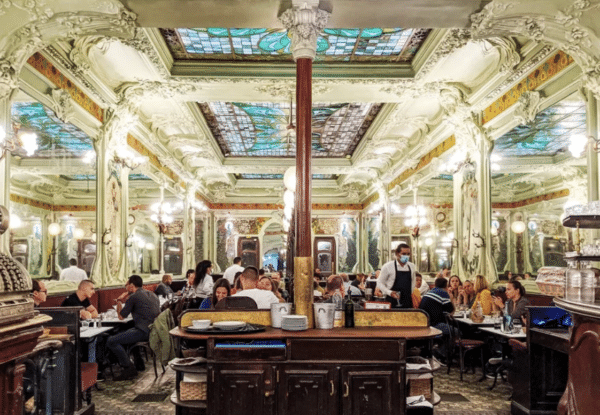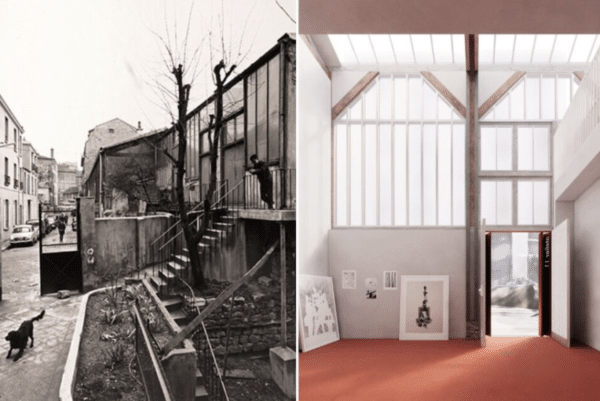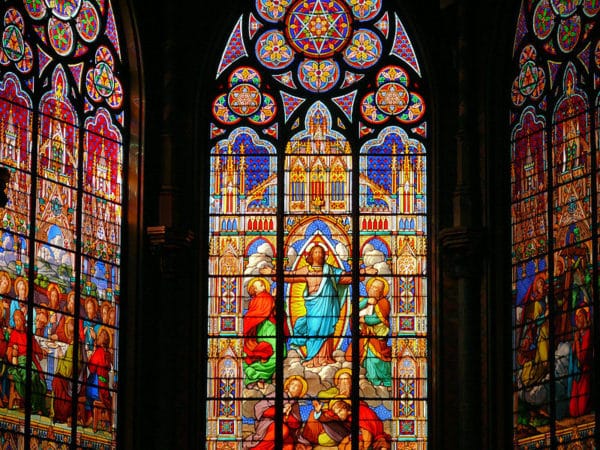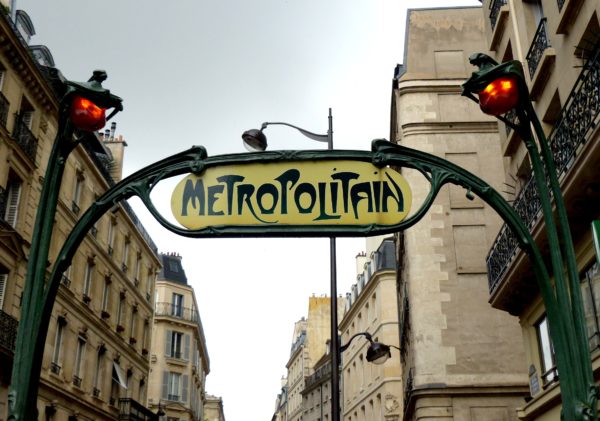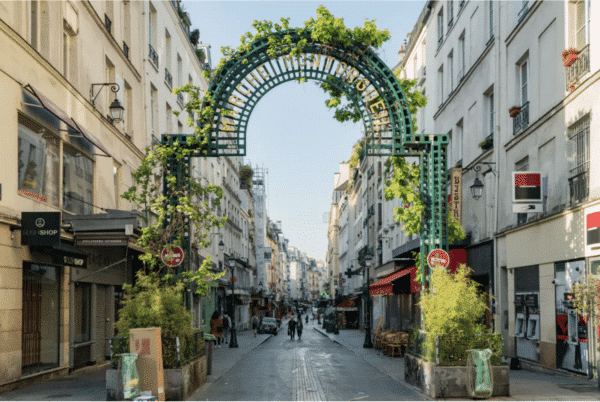This Paris Life
Expert Insight, Breaking News, and Insider Stories on Real Estate in Paris
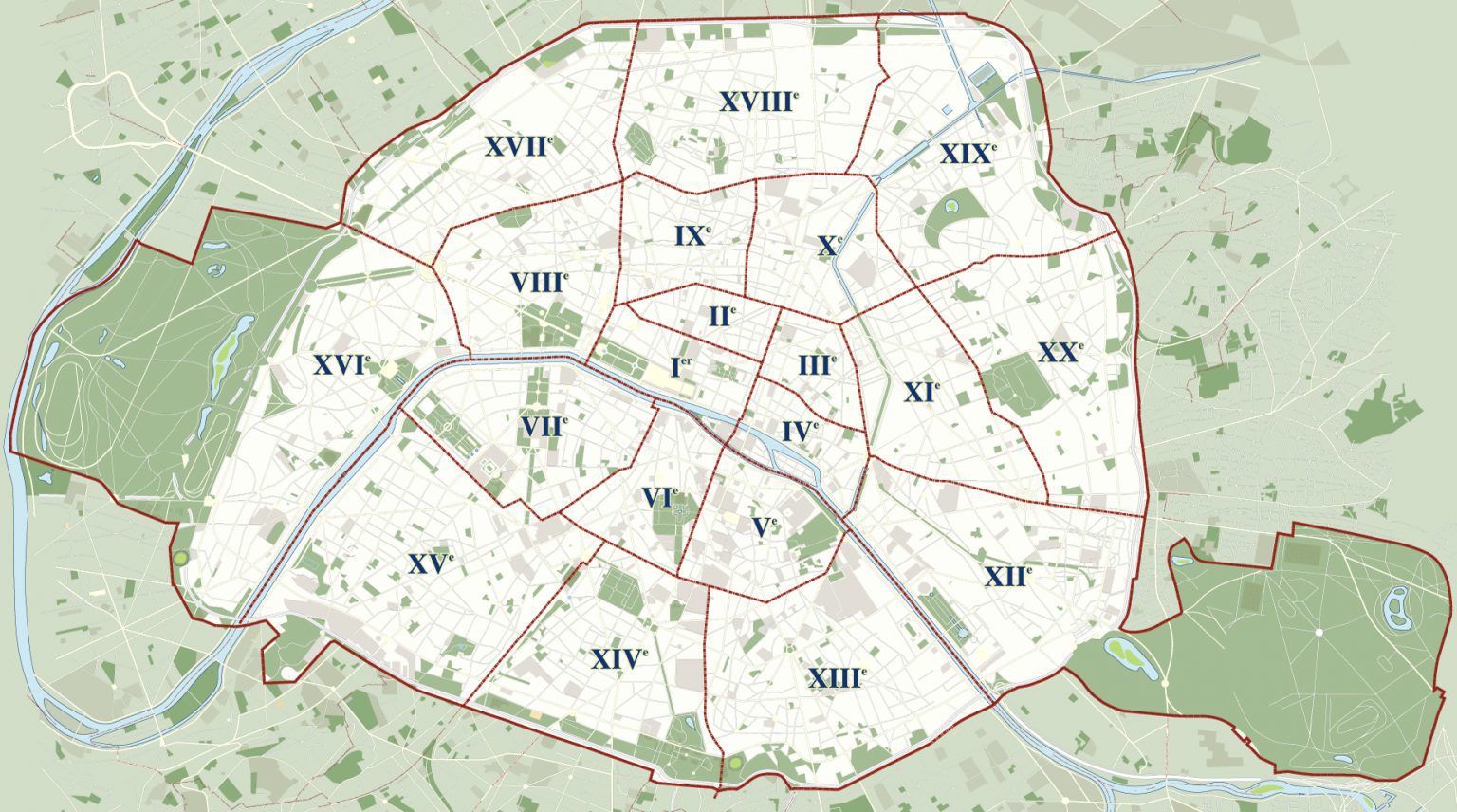
What to Do in the 20 Arrondissements of Paris.
When looking at a map of Paris, you might immediately notice that it resembles a spiral. Some compare the layout to an escargot (snail), referring to the swirling forms of the insect’s shell. This rather dizzying presentation has to do with the arrangement of the city’s 20 arrondissements, or districts, which spiral out clockwise from the very center of the city at the 1st arrondissement (see the roman numeral “I” on the map above) to its outer edges.
This can all be a bit confusing for the unfamiliar, especially since the 20 arrondissements of Paris are not always contiguous (or found next to one another in numeric order). For example, if you get off the train at Gare du Nord in the 10th arrondissement, heading due north will lead you into the 18th, while strolling due south would bring you to the 3rd arrondissement.
To help you get oriented, understand a bit about the city’s key neighborhoods as you plan your trip, and gain an overview of the main sights and attractions to focus on in each, keep reading.
What does “arrondissement” mean? And what’s the history?
The division of Paris by arrondissement (which means “administrative district” in French, or more literally, “rounded area”) was first carried out in 1795. But at the time there were only 12 arrondissements, since many of the present-day city’s outer areas (including Montmartre in the now-18th arrondissement and Belleville/Ménilmontant in the 20th) had not yet been incorporated into Paris.
As the city annexed these suburbs and villages, it gradually gained arrondissements. In 1860, under the plans of Emperor Napoleon III and city planner Baron Haussmann, the initial 12 arrondissements were scrapped, and a new plan for 20 city districts was drawn up.
This is roughly the same division that exists in the present day, although in 2020 arrondissements 1 through 4 (making up the city center) merged for strictly administrative purposes.
How to navigate between Parisian arrondissements (and know which one you’re in)?
Unlike a more recently laid-out city like New York, where street numbers and cardinal directions on signs often allow you to figure out where you are without a map, it’s a bit trickier to navigate the streets of Paris this way unless you learn it by heart.
What’s more, some of the 20 arrondissements of Paris are found on the left bank of the Seine (rive gauche in French) while others are located on the northern side of the river, on the right bank (rive droite). But owing to the counterclockwise spiral formation of the arrondissements, it’s not easy to guess which are found on either side of the river.
So the 4th and 5th arrondissements, for example, would be contiguous with one another north to south, were it not for their separation by the river and its many bridges.
Luckily, nearly any street sign affixed to the corner of a building in Paris will tell you which arrondissement you’re in– which can help a bit in figuring out where you are. But unless you know the city very well, a digital map app or print “Paris par Arrondissements” guide with detailed neighborhood maps is generally necessary for getting around with ease.
Fun-but-somewhat-useless-fact: The 15th arrondissement is the largest Parisian municipal district, while the 2nd arrondissement is the smallest.
Also be aware that Parisian postcodes show the arrondissement at the end of the 5-number code– so 75001 is the 1st, 75010 is the 10th, 75017 is the 17th, etc.
1st Arrondissement: Les Halles, Louvre, Palais-Royal
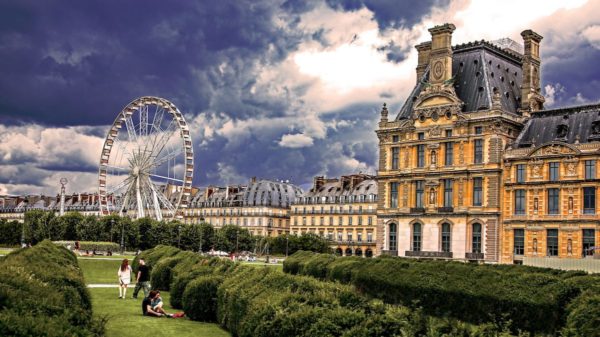
It can be quite muggy in Paris during the mid-summer period. Image credit: Rennett Stowe/Creative Commons
Smack in the heart of Paris on the Right Bank, the 1st Arrondissement harbors some of the city’s largest attractions, lush gardens, as well as several popular (mostly high-end) shopping and dining areas.
The Vibe: Around the Louvre, Tuileries, and Palais-Royal, the area is upwardly mobile, often expensive (including for restaurants and hotel fares) and can be flooded with tourists, especially around the Louvre-Tuileries and the stretch of Rue de Rivoli that faces the palace and garden. Watch for tourist traps and overly-high prices in the area.
Major Metro Stops: Les Halles, Chatelet-les-Halles, Palais Royal-Musée du Louvre, Tuileries
What to See & Do?
There’s tons to keep you busy in the 1st, from seeing countless masterpieces at the Louvre Museum and the verdant lanes of the Jardin des Tuileries, to taking a stroll at the nearby Palais-Royal and browsing its boutiques. The Place Vendôme and its imposing column is lined with high-end jewellery boutiques and dominated by the recently renovated Ritz Hotel.
You may also consider paying a visit to the Bourse de Commerce/Fondation Pinault, a newly inaugratated contemporary art centre built inside the old corn trader’s exchange house. And closer to the banks of the Seine, the newly-renovated Samaritaine department store has become a contemporary temple of luxury in the capital– and boasts some stunning architectural elements.
Further west, the sprawling shopping center (and former marketplace) at Les Halles is a bit grungier, but an excellent place for budget shopping. Meanwhile, the elegant Rue Saint-Honoré is lined with designer boutiques, high-end food shops, and specialty stores.
2nd Arrondissement: Montorgueil, Bourse, Grand Boulevards
Nestled between Les Halles and the “Grands Boulevards” district on the Right Bank (see above and below), the 2nd Arrondissement is at once bustling and full of village-like niches, some of which are pedestrian-only. Less touristy and more local than the 1st, it abounds with markets and restaurants, cozy wine bars and classic old theaters. Owing to its central location and amenities, it can be an expensive choice for hotels, although many excellent restaurants in the area offer reasonable fare, especially at lunch.
The Vibe: The 2nd is at once cosmopolitan and fast-paced (in certain corners), laid-back and reminiscent of an older Paris. The charm in that contrast is considerable.
Major Metro Stops: Etienne-Marcel, Sentier, Bourse, Réaumur-Sebastopol
What to See & Do?
Start by getting off at Etienne-Marcel or Sentier and exploring the Rue Montorgueil and its surrounding streets, a popular semi-pedestrian area famous for its cheerful greengrocers, excellent bakeries, and sidewalk cafés ideal for people-watching.
The covered passageways of Paris, also referred to as “galeries” or “arcades”, offer old-world elegance. Then head west to the area around the Bourse (old stock exchange), exploring some of the area’s elegant covered passageways (arcades) and meandering side streets. Galerie Vivienne and Passage des Panoramas are among the historic arcades to spend some time meandering through, or stopping for coffee within its ornate, glass-roofed interiors.
The Grand Colbert restaurant is one historic brasserie in the Galerie Vivienne that’s both picturesque and an accessible spot for a traditional French lunch or dinner.
3rd Arrondissement: Temple, Upper Beaubourg, Le Marais
One of the quieter stretches of the rive droite and taking up the northern, more residential parts of the neighborhood known as the Marais (see below), the 3rd Arrondissement offers some interesting, not particularly touristy havens while still quite central. At its very edge is the colorful Centre Pompidou (see below), while the streets around the verdant Square du Temple have seen a new crop of stylish restaurants, boutiques, and cafés open in recent years.
The Vibe: Relatively quiet but stylish, the 3rd is a more relaxed place to stay near the city center (and can be a bit less expensive than surrounding areas, since it’s less in demand by tourists.
Main Metro stops: Temple, Arts et Métiers, Rambuteau
What to See & Do?
Musée Carnavalet in Paris, a city history museum, re-opened in May 2021 after renovations
Musée Carnavalet, a city history museum in the 3rd arrondissement, re-opened in May 2021 after renovations
Explore the fascinating, old-world collections relating to the history of science and industry at the Musée des Arts et Métiers, or the recently-renovated Musée Carnavelet (dedicated to the history of Paris), and the Picasso Museum, boasting one of the world’s most impressive collections of works from the Franco-Spanish master.
Take a stroll through the quieter parts of the upper Marais, dotted with gardens, handsome residences and excellent restaurants. Explore the hip area around the Square du Temple and perhaps stop for lunch.
Meanwhile, some of the streets around Metro Arts et Métiers and Temple, including the northern part of Rue du Temple and its surrounding streets, are dotted with cool, contemporary little cafés serving excellent coffee, stylish boutiques, record shops and excellent bakeries.
4th Arrondissement: Le Marais, Beaubourg, Ile de la Cité, Ile Saint-Louis
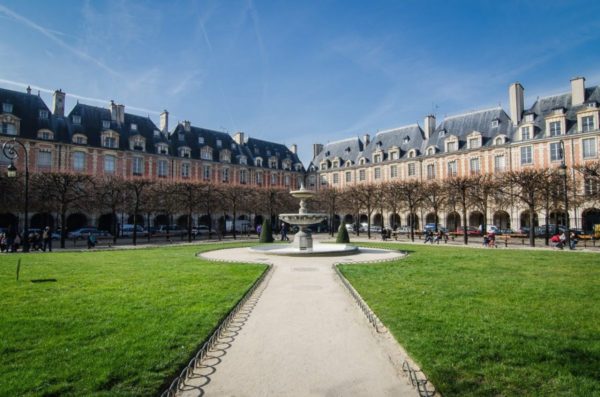
Place des Vosges
Place des Vosges is one of the prettiest squares in Paris, and in the 4th.
Stretching from the Marais to the east on the Right Bank and then over the Seine to two of its natural islands, the Ile de la Cité and the Ile Saint-Louis, the 4th is almost-always bustling. Alluringly cosmopolitan while also boasting history on every corner, this is one of the city’s most-popular arrondissements among both locals and tourists.
The Vibe: Elegant and style-savvy, this is a lovely spot. It also tends to be quite expensive to stay and eat here, occupied by fashionable restaurants and boutique hotels that don’t hesitate to capitalize on the area being so much in demand.
Main Metro Stops: Hôtel de Ville, Saint-Paul, Pont-Marie
What to See & Do?
Centre Pompidou in Paris, France
Start at Metro Hotel de Ville and admire Paris City Hall, before heading a few blocks over to the quirky, colorful Centre Georges Pompidou, the heart of cultural Paris and one of the best places for a modern art exhibit, meal, and/or panoramic views over the city from the top floor.
From the area around the Pompidou, known locally as “Beaubourg”, head into the heart of the Marais district and take in its elegant hotels particuliers (mansions), narrow streets lined with shops and cafés, and perhaps grab some falafel or babka in the old Jewish quarter around Rue des Rosiers. Stop at the breathtaking 13th-century Place des Vosges, flanked with Renaissance-era mansions, shops and restaurants.
You may also want to explore the many medieval sites in the Marais and throughout the 4th, taking a self-guided or virtual tour.
Crossing the bridge near Hotel de Ville or Pont-Marie into the part of the 4th that sprawls over the Ile de la Cité, witness the marvels of Notre-Dame Cathedral and the Sainte-Chapelle, before hopping over to the Ile Saint-Louis for picturesque views over the riverbanks and Notre-Dame, more tony streets and residential facades, and the legendary ice cream at Berthillon.
5th Arrondissement: Latin Quarter
Somewhere in the Latin Quarter. Pick a bench and enjoy the people passing by.
Moving to the Left Bank of the Seine for the first time as we count down the full 20 Paris arrondissements, the 5th takes up the vast majority of the beloved Quartier Latin (Latin Quarter)— a center of intellectual and artistic vibrancy since at least the medieval period. Home to some of France’s most-prestigious and well-known universities, including the Sorbonne, the Latin Quarter captures the sort of old-world, Romantic Paris that many visitors imagine before they arrive, thanks in part to its countless depictions in films and books.
The Vibe: Some stretches are bustling and crowded (especially with tourists), while others are remarkably quiet and residential. Hotels and restaurants tend to charge high prices in the area, but some deals are possible. Beware of tourist traps, especially in certain streets around Metro Saint-Michel.
Main Metro Stops: Saint-Michel, Cluny-la-Sorbonne, Place Monge, Censier-Daubenton
What to See & Do?
There are several interesting and semi-enchanted areas to explore. I suggest starting at the point closest to the Seine, at Metro Saint-Michel. See the famous fountain of the saint of the same name slaying a dragon on the square, then explore the surrounding streets, popping into the area’s many bookshops and fine art stores. Shakespeare and Company and Gibert Jeune are two historic hubs for bibliophiles in the area.
Head south down Boulevard Saint-Michel to see the famous Sorbonne University; the fine collections of medieval art and tapestries at the Musée Cluny (as well as admiring impressive traces of Gallo-Roman Paris in its foundations and old baths). Next, explore the streets around the University, perhaps stopping for a matinée movie at beloved Quartier Latin cinemas like the Champo or the Reflet Medicis.
Walk up the hill to the Panthéon, a mausoleum where celebrated French figures are laid to rest, and head behind it to reach the much quieter Monge/Mouffetard area. Aside from the always-busy, ancient Rue Mouffetard and its permanent market, this is a residential area whose tranquil courtyards, winding back streets, and old Roman ruins (at the Arènes de Lutèce) show a much more laid-back, local side of an otherwise touristy district.
Next, amble along the quays of the Seine from the Quai de la Tournelle, across from Notre-Dame, westward toward the Quai de Conti and the Quai Voltaire in the 7th arrondissement. On the way, stop at one of the many outdoor booksellers (bouquinistes), with their iconic metal stands in deep green.
In addition to a large selection of used and rare books, they also sell vintage illustrations and engravings, film posters, maps, postcards, and Paris memorabilia.
6th Arrondissement:
Just west of the Latin Quarter on the Left Bank, the 6th Arrondissement stretches across much of the area also known as Saint-Germain-des-Prés, whose roots stretch to the early medieval period, as evidenced by its 6th-century Abbey Church of the same name.
Like the nearby Latin Quarter, St-Germain has been a center of religious, scholarly, literary and philiosophical activity for centuries, from the monks who presided over a rich library of manuscripts at the Abbey (sadly later destroyed in a fire) to the 20th-century writers and intellectuals that congregated around the area’s legendary cafés. Today, it’s popular for its restaurants, ample boutiques and shops, lush gardens, and tony lifestyle.
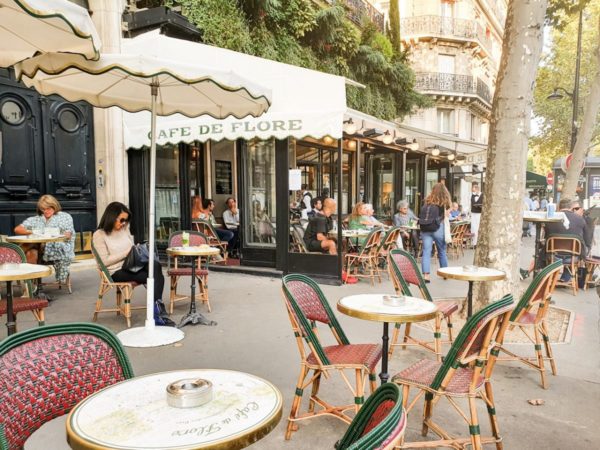
The Vibe: Saint-Germain is often described as being a bit staid and conservative, and the charge isn’t entirely untrue. This is an upwardly mobile area abounding with designer boutiques, posh residential buildings, and cafés that often charge quite a bit for a simple cup of coffee.
But it’s also full of vibrancy, historic interest and excellent food shops, restaurants and wine bars, where some of Paris’ most creative chefs preside over tables that are surprisingly accessible (Jean-François Piège’s friendly bistrot Clover Green is one of them). Do expect to pay handsomely for hotel rooms in the area.
Main Metro Stops: Saint-Germain-des-Prés, Odéon, Saint-Sulpice, Mabillon
What to See & Do?
Start by getting off at Metro Saint-Germain-des-Prés and visiting the Abbey Church at the exit. It boasts some impressive medieval elements, including fine stained glass and a handsome tower dating to the beginning of the 11th century.
Next, wander down Boulevard Saint-Germain and stop for coffee at one of the area’s iconic cafés, Café de Flore or Les Deux Magots, where philosophers including Sartre and De Beauvoir and writers such as James Baldwin often congregated to argue, chain smoke and draft novels in notebooks. Today, the cafés mainly attract tourists–but they still make for an interesting stop.
Head south to the green lanes of the Jardin du Luxembourg to admire its fine Italian-style palace and formal gardens, statuary, ponds and wooded paths. The area was frequented both by many prominent African-American writers and painters (such as Baldwin, Richard Wright, and the painter Beauford Delaney) as well as famous American women like Gertrude Stein, Alice B. Toklas, and Sylvia Beach, owner and founder of the original Shakespeare and Company bookshop.
If shopping is of interest to you, exit the Luxembourg Garden and wander through St-Germain’s many narrow little streets, lined with fashionable boutiques and excellent food shops. The area around the Marché Saint-Germain shopping center is a good place to start (Rue Clément); Rue de la Seine and surrounds is ideal for antiques and fine arts.
7th Arrondissement: Musée d’Orsay, Eiffel Tower, Trocadero
Heading further west on the Left Bank and to the area that’s probably the most-easily identified by tourists, the 7th Arrondissement houses iconic sights including the Eiffel Tower and the Champ de Mars, Invalides military hospital, and the stunning modern art collections of the Musée d’Orsay.
The Vibe: Classical, grandiose and quite touristy in many stretches, the 7th also reserves quieter, more residential areas boasting quaint market streets, squares and shops. It’s generally an affluent neighborhood where you can expect hotel fares and restaurant prices to be on the steep side. Watch out for tourist traps around the Eiffel Tower-Trocadero area.
Main Metro Stops: Pont de l’Alma, Rue du Bac, La Tour-Maubourg, Ecole Militaire
What to See & Do?
I recommend starting with a visit to the incredible collections of the Musée d’Orsay, whose permanent collection includes impressionist and expressionist masterpieces from Monet, Manet, Dégas, Cézanne, Van Gogh, and countless others, as well as fine displays of decorative objects and early modern sculptures.
Next, hop on the Metro or RER (commuter-line train) and head to see the Eiffel Tower, preferably climbing to the top via elevator and seeing the city stretched out before you from its heights. Then stroll around the grand Champs de Mars and the area known as the Trocadero, well-known for its enormous green lawns.
Also in the area is the Hôtel des Invalides, a former military hospital that houses the tomb of Emperor Napoleon I; the nearby Musée de l’Armée is interesting for anyone curious about French military history.
Meanwhile, the Rodin Museum and its magnificent open-air sculpture garden is an under-appreciated gem in the capital, housing masterpieces from France’s most-famous sculptor, as well as several from his student and successor Camille Claudel. It’s especially inviting in the summer, when the outdoor sculpture garden teems with roses.
Moving to the quieter and more residential part of the 7th arrondissement, head to Rue Cler, a cheerful permanent market street lined with greengrocers, cafés, excellent bakeries and foodshops. The surrounding streets abound with charming little niches, local boutiques, and green spaces.
Finally, around the Rue du Bac area at the border of the 6th arrondissement, Le Bon Marché department store is one of the city’s oldest and grandest, notable both for its fine architecture and endless wares, from designer clothing to gourmet food halls (at the La Grande Epicérie indoor market).
8th Arrondissement: Champs-Elysées, Madeleine

Crossing the river again back to the Right Bank, the 8th Arrondissement is a large area stretching east to west from the Place de la Concorde to the Avenue des Champs-Elysées and its famous triumphal arch at its end, and also comprises important commercial and residential stretches around Place de la Madeleine, Rue du Faubourg Saint-Honoré, and Rue La Boétie.
The Vibe: Grandiose and classical, the 8th arrondissement is home to some of the city’s most-recognizable, prestigious streets and monuments. It’s an area oversupplied with luxury boutiques, high-end restaurants, and elegant lanes. Not surprisingly, then, you can expect hotel fares and prices per head for dining out to be higher here.
Main Metro Stops: Concorde, Champs-Elysées Clemenceau, Madeleine, Franklin D. Roosevelt, Charles de Gaulle-Etoile
What to See & Do?
The Grand Palais hosts many of the early fall season’s most exciting exhibitions.
There’s a wealth of things to see and do in the area. Start at the Place de la Concorde and walk across the enormous square with the famed Egyptian Obelisk at its center, accessing the beginning of the Avenue des Champs-Elysées on the other side.
Walk up the wide avenue studded with sidewalk cafés, boutiques and shops, perhaps stopping for an exhibit at the Grand Palais, an elegant glass-roofed pavilion built in 1900 that now hosts some of the city’s blockbuster art shows and other events. The Théâtre des Champs-Elysées and the Petit Palais are other sites of interest in the area, one for theatre and the other for fine art shows.
At the summit of the “Champs”, the imposing Arc de Triomphe comes into view, a monumental decorated arch rising from the head-spinning, star-shaped traffic circle at the Place de l’Etoile. The arch was commissioned by Napoleon I to celebrate his military victories, and is emblematic of Parisian pomp and circumstance.
For shopping (whether you’re looking for clothing or accessories, gourmet food items, or gifts), head to the Madeleine metro stop and browse the area’s numerous boutiques. The Rue du Faubourg Saint-Honoré (leading into the Rue Saint-Honoré in the 1st arrondissement; see above), is also ideal for window and gift-shopping– but be aware that the prices run quite high in the area.
9th Arrondissement: Opéra, Grands Boulevards, South Pigalle

For a glimpse at Paris as it may have appeared during the Belle-Epoque– the era stretching from the end of the 19th century to the beginning of the 20th– beeline to the 9th arrondissement. Home to grandiose department stores with elaborate glass and metal rooftops, the original Parisian Operahouse, and the Grands Boulevards– a network of wide streets that were a favorite subject among impressionist and expressionist painters for their exhilarating modernity– this is a district that sometimes appears to have remained stuck in time. Yet look more closely, and there’s plenty of contemporary vibrancy there too, especially in the area known as South Pigalle.
The Vibe: Elegant and urban, the 9th manages to feel bustling without being overly stressful, and grandiose without being snobby. More accessible than ultra-luxe areas in the Right Bank such as Place Vendôme and the Rue Saint-Honoré, the 9th generally harbors more moderately priced hotels and restaurants (although there are still plenty catering to a high-end crowd here, too).
Main Metro Stops: Opéra, Richelieu-Drouot, Grands Boulevards, Saint-Lazare, Saint-Georges
What to See & Do?
The Opera Garnier is a major attraction in Paris’ 9th arrondissement.
A first stop at the Opera Garnier and the imposing Avenue de l’Opéra is in order, whether or not you choose to tour the lush interiors of the 19th-century masterpiece, now home to the Paris National Ballet. Next, explore the Boulevard Haussmann, home to the legendary department stores Galeries Lafayette and Printemps.
The Grands Boulevards district stretches through and beyond Boulevard Haussmann, continuing along Boulevard des Italiens and Boulevard Montmartre. Sights such as the Grévin Wax Museum, historic covered passageways like the Passage Jouffroy, and legendary theatres like the Folies-Bergère (where performers such as Josephine Baker once drew large crowds) are all worthwhile, as are the area’s numerous excellent cafes and restaurants.
In the northern part of the 9th, approaching Montmartre and Pigalle, the stylish neighborhood known as South Pigalle is a major destination for anyone interested in good food; wander through the Rue des Martyrs and surrounds for an excellent selection of bakeries, specialty food shops, restaurants and cafes.
The Delmontel Bakery on Rue des Martyrs, a popular market street in the 9th.
Finally, at the western edge of the 9th, you’ll find the Gare Saint-Lazare, an always-busy train station and commercial area abounding with shops and restaurants.
10th Arrondissement: Gare du Nord, Canal Saint-Martin
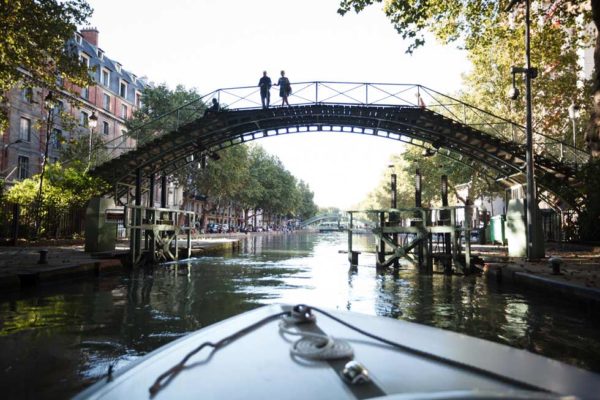
Dynamic, urban and contemporary, the 10th arrondissement is one of the Right-Bank areas that (arguably) more accurately reflects dominant Parisian culture in its present day, with its mix of gritty urbanism and forward-thinking cool. Situated at the edge of northeastern Paris, it’s still central enough to feel close to the buzz and action of the capital’s heart– yet it has something entirely its own.
The Vibe: Bustling and busy, the 10th is rarely a tranquil place– even nearby the Canal Saint-Martin, which is generally swarming with people despite being a green haven in the area. This is a traditionally working-class district which is increasingly gentrifying, especially around the Canal; trendy boutiques, wine and cocktail bars, artisan cheese shops and gourmet street food joints are popping up in many corners of the arrondissement.
Main Metro Stops: Gare du Nord, République, Jacques-Bonsergent, Strasbourg Saint-Denis
What to See & Do?
Inside the Gare du Nord, Paris
The 10th harbors few “big-ticket” tourist attractions, but exploring it reveals much about the diversity and vibrancy of present-day Paris. Start at Metro Gare du Nord and see the exterior of the old train station of the same name– a gateway to Northern France and Europe and home to the Eurostar station.
Wander up Rue du Faubourg Saint-Denis and stop for a budget-friendly lunch at one of the area’s many excellent Indian and Sri Lankan restaurants; this is the heart of La Chapelle, home to large communities from the Indian subcontinent.
Head east towards the appropriately named Gare de l’Est station and Metro stop, then keep on the same course to reach the Canal Saint-Martin, a former shipping canal whose picturesque metal footbridges, lively restaurants, cafes, boutiques and bars draw crowds of locals both day and night. Riverboats regularly pass through the canal, ferried through an elaborate lock system that rapidly fills and empties the basin with water.
Meanwhile, the areas around Metro Strasbourg Saint-Denis and Chateau d’Eau are also worth checking out; these are diverse working-class neighborhoods where signs of gentrification abound, as evidenced by its newer bars, restaurants, cafes and clothing shops. But the many greengrocers specialising in products from around the globe, Asian-themed restaurants, African hair salons, and old-world Parisian brasseries designed to cater to working-class diners show that the district remains one of the most diverse– and hardest to pin down.
There are some stunning (albeit under-appreciated) architectural details in the Strasbourg Saint-Denis area in particular, including the Passage Brady (an old covered passageway famous for its Indian restaurants) and the Porte Saint-Denis, an enormous decorated arch dating to the 17th century. The Porte was once part of the old fortified wall that surrounded Paris under King Charles V.
11th Arrondissement: Bastille, Oberkampf, République
Nestled on the Right Bank just northeast of the city center, the 11th is a favorite among young professionals, students and artists, who appreciate the moderate rents, abundant nightlife, unusual number of cool, creative new eateries, work cafés and general cosmopolitan energy. One of the largest of Paris’ arrondissements, it stretches from the Place de la Bastille to the Place de la République north to south, and west to east to the edge of Père-Lachaise Cemetery and Belleville (the latter in the 20th arrondissement).
The Vibe: Youthful, energetic, gritty and diverse, the 11th is one of the most tightly-packed areas both from a standpoint of residents per capita and the layout (narrow streets abundant with cafes, restaurants, bars, shops, and residential buildings). It’s an excellent area for people-watching and partying, but not especially for peace and quiet or abundant greenery. Hotels in the area tend to have moderate rates, and there are many creative restaurants in the area offering superb value.
Main Metro Stops: Bastille, République, Goncourt, Oberkampf, Saint-Sebastien Froissart, Saint-Maur
What to See and Do?
Since the 11th is so large, it’s unlikely that you’d want to try to see it all in one morning or afternoon. Instead, head to one of the following areas and explore them individually:
Joining several arrondissements at its edges, the dizzying Place de la Bastille lies at the gateway to the 11th via Rue de la Roquette or Boulevard Richard Lenoir. After taking in the sights of the busy square– from the sleek metal and glass facade of the Bastille operahouse to the Colonne de Juillet, a monument commemorating the Revolution of 1830, explore the busy Rue de la Roquette, with its many restaurants, bars, cafes and style-conscious boutiques.
Lying just northeast, the Boulevard Richard Lenoir is home to one of the city’s most popular open-air markets (held on Thursday and Sunday mornings).
To the north, Place de la Republique is another monstrous square that in fact joins several arrondissements, including the 11th (via Boulevard Voltaire). The square is famous for its imposing statue of Marianne, symbol of the French Republic. It is also a popular spot for protests and other public gatherings. This part of the 11th lies right at the border of the 10th, in close reach of the Canal Saint-Martin (see above).
Meanwhile, the Oberkampf neighborhood (roughly defined here as the large area around Metro Oberkampf, Saint-Maur, Goncourt and Saint-Sebastien Froissart) is a major destination for after-hours fun in the capital, from late-night dining to lively bars and indie dance clubs. It also abounds with street art, small galleries, and popular new museums such as the Atelier des Lumières, which stages monumental digital art shows.
12th Arrondissement: Gare de Lyon, Aligre, Charonne
Melding classic and ultra-contemporary Parisian landscapes, the 12th arrondissement is a fascinating, hybrid district with several interesting and distinctive areas. It sprawls for an incredible length on the right bank, bordering the Bastille area to the west, hugging the Seine at various points and stretching east to the Bois de Vincennes park.
The Vibe: Neither posh nor working-class, the area is decidedly middle-class, with lots of quiet, residential areas surrounded by markets and green spaces. Prices are also in the mid-range at hotels and restaurants here, on average. It’s increasingly considered cool, although this wasn’t always the case, owing to a new crop of boutiques, restaurants, bars and cafes, especially in the neighborhood known as Charonne.
Main Metro Stops: Gare de Lyon, Bercy, Faidherbe-Chaligny, Charonne, Château de Vincennes
What to See & Do?
As one of the city’s largest arrondissements, there are several key areas to explore in the 12th , and it may prove too ambitious try covering all of it in a single day.
First, the area around the Gare de Lyon train station (and Metro) is bustling and international, with travelers roaming around the streets, or stopping for lunch at the iconic Le Train Bleu brasserie on the mezzanine level of the station (one of Paris’ most beautiful restaurants).
Adjacent to the Gare de Lyon is Bercy, home to an ultra-modern shopping center, park and surrounding neighborhood bordering the Seine that’s ideal for shopping, cinema, and long strolls. The Bercy Village shopping center is built in former 19th-century winery warehouse, and is popular among locals.
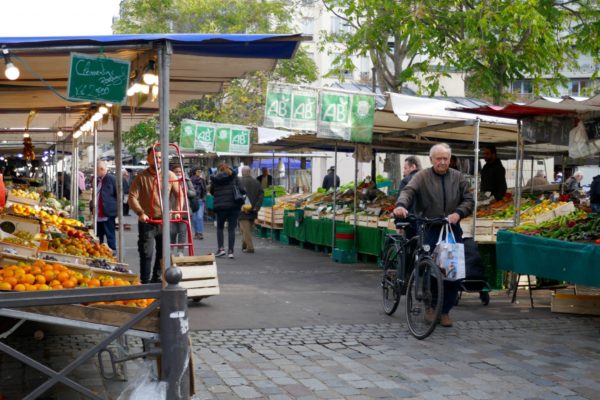
Next, the area around the Place d’Aligre is coveted for its open-air market (and covered counterpart), artisan food shops, and excellent wine bars and restaurants.
The area of the 12th leading from the Place de la Bastille includes the stunning Promenade Plantée, a greenery-lined walking path built above street level on a defunct railway.
Below parts of it are the shops and cafes of the Viaduc des Arts, whose boutiques and restaurants are built into the red-bricked niches of a former viaduct.
Next, the Charonne neighborhood is probably the 12th’s hippest, showing rapid signs of gentrification in the past few years and full of creative bistros and wine bars, fashion boutiques, small galleries and and otherwise arty enclaves.
Finally, at the very eastern edge of the 12th you’ll find the lush Bois de Vincennes, a former royal wood and hunting ground that was transformed into one of Paris’ largest public parks. It harbors a fortified medieval chateau, numerous ponds and walking paths, restaurants, and a floral garden that hosts al fresco jazz concerts in the summer.
13th Arrondissement: Place d’Italie, Asian Quarter, Bibliothèque Nationale, Butte aux Cailles
Heading due south on the Left Bank, the 13th arrondissement is one of the areas that remains relatively little-known to tourists, in part due to its lack of iconic monuments and attractions. Yet visitors should give the district a closer look. From the sleek National Library district near the Seine to the quirky charms of Chinatown and the village-y Butte aux Cailles, there’s a surprising wealth of quietly fascinating sites in the 13th.
The Vibe: At turns starkly contemporary and even futuristic, at turns reminiscent of a tiny French village somewhere, the 13th is painted in contrasts. Quiet residential areas give way to a lively Asian Quarter studded with restaurants and supermarkets, abundant street art, and to enormous open spaces and plazas where crowds are rarely observed. Prices in the 13th—whether in hotels or restaurants—tend to offer good value.
Main Metro Stations: Tolbiac, Place d’Italie, Bibliothèque, Glacière, Corvisart
What to See & Do?
Bibliotheque-nationale-Paris
Start in the Bibliothèque Nationale area, an ultra-modern district on the banks of the Seine with wide-open spaces and sleek architecture, including the Francois-Mitterand (National) Library, the Simone de Beauvoir footbridge, the Cité de la Mode et du Design (Center of Fashion and Design) on a site called the Docks, and the Josephine Baker Pool, the latter ideal for a summer dip.
The library boasts hundreds of thousands of books, gallery spaces with interesting exhibits on literary and book history, restaurants and cafes, and spaawling terrace areas offering interesting and unexpected views over the area. There’s also a major cinema on the site (MK2 Bibliothèque), and several cafes, pubs and restaurants to choose from.
Next, head to Place d’Italie, a dizzyingly large square flanked with highrise buildings and focused around a large shopping center. From there, wander into the Asian Quarter around Avenue de Choisy, Avenue d’Ivry and Boulevard Masséna. It’s in this area that the largest annual Chinese New Year parades and festivals take place, and you’ll find many excellent Asian restaurants, primarily specialized in cuisine from Vietnam, Thailand, China and Cambodia, in the area.
Chinese New Year generally falls in February, and celebrating is a good way to inject some color and festivity into the month. Maciej Zgadzaj/Creative Commons
Chinese New Year generally falls in February, and celebrating is a good way to inject some color and festivity into the month. Maciej Zgadzaj/Creative Commons
From Metro Corvisart, explore the old working-class village of the Butte aux Cailles, a district coveted by Parisians for its art-deco architecture, Alsatian-style workers’ villas dating to the early 20th century, colorful street art and murals, and narrow streets dotted with restaurants and cafes.
The Butte aux Cailles is a residential, fascinating neighborhood in Paris whose art-deco architecture is a real draw card.
The Butte aux Cailles is a residential, fascinating neighborhood in Paris whose art-deco architecture is a real draw card. Image: Courtney Traub/All rights reserved
The Art-Deco pool (Piscine de la Butte aux Cailles) and natural artesian well outside it on Place Paul Verlaine are especially noteworthy. The Bièvre river, a tributary of the Seine, runs beneath the area and its pristine waters can still be enjoyed for free by all, despite the river being paved over.
Bring a bottle or thermos to taste some cooling water from the well, which also feeds the pool. The continue to explore the streets of the Buttes aux Cailles beyond it, perhaps stopping for a drink or lunch in one of the neighborhood bistros whose facades are often decorated with street art.
14th Arrondissement: Montparnasse, Denfert-Rochereau, Cité Universitaire
Below the Latin Quarter and stretching from Montparnasse and its bustling boulevards to the Cité Universitaire (University City) and the Romantic-style Montsouris Park, the 14th is a Left-Bank district that’s at turns exciting and cosmopolitan, sleepy and charmingly residential. It harbors some of the key sites for anyone interested in Parisian literary and artistic history.
The Vibe: Depending on where you’re roaming or staying, the vibe alternates between busy and exciting to laid-back and almost provincial. The artistic history is apparent in the area’s many old studios, galleries and theatres, as well as small museums. You can often find good deals on hotel rates, lunch and dinner in the 14th, owing in part to its semi-remote location. But links to the city center are quick and excellent.
Main Metro Stations: Montparnasse-Bienvenue, Vavin, Denfert-Rochereau, Pernéty, Alésia
What to See & Do?
Rich in artistic and literary history, Montparnasse is arguably the cooler cousin of the Latin Quarter and Saint-Germain (see arrondissements 5 and 6 above). At historic brasseries and cafes such as La Coupole (see my full review) and La Rotonde, the ghosts of artists, performers and writers from Picasso to Colette, Marc Chagall to Hemingway and Tamara de Lempicka draw visitors to lunch indoors or out. Art studios and shops, such as the Academie de la Grande Chaumière, still testify to that deep legacy of creation in the area.
Meanwhile, the many famous figures buried at the lovely, greenery-rich Montparnasse Cemetery are worth paying a visit to. And if you’re hungry, the area harbors some of the best creperies in the city.
The adjacent Gäité area (at the Metro stop of the same name) is famed for its tiny old theatres, most dating to the nineteenth century. There are also several good restaurants and cafes located along the narrow little streets of this “micro-quarter” , serving good food at generally reasonable prices.
In the area around the Pernety Metro stop, you’d be forgiven for thinking you’ve left Paris entirely and find yourself in a sleepy village somewhere. A traditional market street on the Rue Raymond Losserand abounds with shops, produce sellers and cafes, and there are numerous quiet little lanes, private villas, and impasses (no-through streets) in the area, teeming with flowers and plants, roamed by cats and framed by little houses.
Heading to the area around the Denfert-Rochereau Metro/RER station, the Paris Catacombs beckon, drawing you hundreds of feet underground to witness millions of skulls, femurs and other human remains neatly and compactly stacked in corridors stretching nearly a mile.
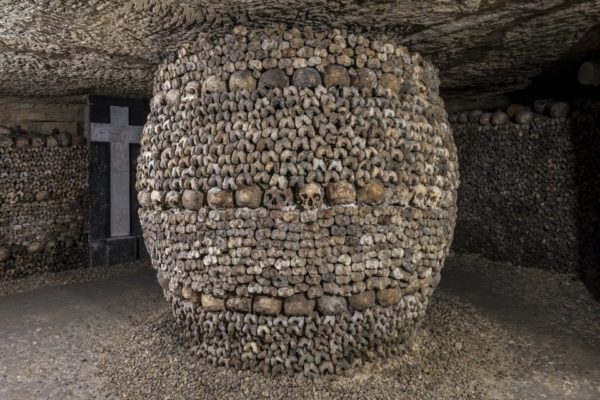
Meanwhile, the cheerful market street at Rue Daguerre is quaintly old-world, and is dotted with numerous cafes, restaurants, greengrocers, traditional food shops and old boutiques. It’s changed a lot, however, since the legendary filmmaker Agnès Varda made a love-letter documentary about the street on which she once lived, called Daguerréotypes.
Finally, heading further south towards the Alésia station, the verdant Parc Montsouris is one of the prettiest in the capital, and the Cité Universitairé is an interesting assembly of buildings in various architectural styles, all housing university students from different countries.
15th Arrondissement: Javel, Bir-Hakeim, Île aux Cygnes, Convention Center
The 15th is another Left-Bank arrondissement that’s appreciated by locals for its genuine sense of peace. Best-known for its sprawling convention center and quiet river parks, it’s not an especially touristy area, lacking in the big-ticket sights and museums that draw hordes elsewhere in the city. Yet it’s an interesting, picturesque area for a stroll when you want to see a different, more residential side of Paris, and also harbors some excellent restaurants, bakeries, riverside areas, museums and parks.
The Vibe: Residential and relatively affluent, the 15th is full of handsome buildings and houses, trees, verdant parks, waterside areas, and a couple small museums worth visiting. Despite its reputation for being quiet and laid-back, this is actually the largest and most-populated arrondissement in Paris! And on the north side, as you get closer to the Eiffel Tower and the city center, the vibe gets livelier. Prices here are moderate to high, with some hotels and restaurants offering excellent value owing to their semi-remote locations.
Main Metro Stations: Convention, Porte de Versailles, Javel-André Citroën, La Motte-Piquet Grenelle
What to See & Do?
The 15th being the largest district in the capital, there are several distinctive areas (some of which are mostly residential). The main sights and attractions of interest to tourists include the following:
The area around La Motte-Piquet Grenelle metro station offers interesting left-bank views of the Eiffel Tower, especially from the Pont Bir-Hakeim, widely considered one of the most stunning bridges in Paris.
Heading down the river towards the metallic Pont de Grenelle, the lush, uninhabited natural island known as the Île aux Cygnes (Swan Island) is a beautiful spot for a stroll, offering 360-degree-views of the river, bridges, Eiffel Tower, and surrounding arrondissements.
It is home to an impressive replica of the Statue of Liberty, cast by Bartholdi, and features a long walking path called the Allée des Cygnes.
Next, the area around Javel-André Citroën is home to the Parc André Citroën, a contemporary green space with thematic gardens and hot air-balloon rides that proffer panoramic views of the city.
In the part of the 15th that joins Montparnasse (bordering the 14th), interesting sights include the Musée Bourdelle, a small museum dedicated to the stunning work of the sculptor Antoine Bourdelle. The Tour Montparnasse, the highest skyscraper within the city walls, is also technically located in the 15th.
Finally, in the southern part of the arrondissement, the Paris Expo-Porte de Versailles convention center is an enormous complex hosting some of the city’s most popular annual trade shows and events, including the Paris Book Fair and the Salon du Chocolat (Chocolate Show).
16th Arrondissement: Passy, Trocadero, Bois de Boulogne
Elegant and classical, the 16th arrondissement is one of the city’s most affluent areas, full of stately mansions, greenery, high-end restaurants and boutiques, large and small museums. While it can sometimes feel a bit inaccessible or intimidating, the district stretching along the western edge of the Right Bank rewards visitors with plenty of eye-catching architecture, trees, and village-like areas that feel surprisingly quaint.
The Vibe: As mentioned above, this is an upwardly mobile part of the city where large residential properties and handsome old buildings (many showing beautiful Art-Deco elements) are interspersed with lush green spaces, shopping areas, restaurants, and riverside areas with a more contemporary feel. Prices tend to be quite steep in this area, which is not ideal for a budget stay.
Main Metro Stations: Passy, Bir-Hakeim, Porte d’Auteil, Les Sablons
What to See & Do?
The Maison de Balzac is a charming free museum in the 16th arrondissement
There are several interesting and worthwhile areas to explore in the 16th, but be aware that this is a large arrondissement, and taking the Metro or bus from one point to the next is often wise.
The Passy neighborhood, stretching from Metro Passy in the east to La Muette in the west, is quiet, leafy, and full of subdued charm. Visit its main shopping areas and markets,, winding, steep lanes, and residential streets abounding with Art-Deco buildings. It’s also home to charming free sites such as the Passy Cemetery and the Maison de Balzac museum (housed in the former residence of the famous writer).
Next, the Place de la Trocadero and Palais de Chaillot are prestigious, expansive sites with stunning views of the Eiffel Tower. Major museums in the vicinity include the Modern Art Museum of the City of Paris (free) and the Palais de Tokyo (right next door). Both are among the best modern art museums in the capital.
Reaching closer to the Bois de Boulogne (the sprawling wood and leisure complex that’s very much worth exploring), you’ll find family-friendly attractions such as the Jardin d’Acclimatation, an old-world amusement park with rides, games, a petting zoo, restaurants and more. The Jardin de Ranelagh is also a good choice, with large playgrounds and pony rides.
Finally, museums such as the recently opened Fondation Louis Vuitton (housed in a dramatic building from architect Frank Gehry) and the Musée Marmottan Monet (boasting numerous impressionist masterpieces from Monet and others) round out the cultural fare in the 16th.
17th Arrondissement: Batignolles, Clichy
One of the most under-appreciated and explored areas on the Right Bank, the 17th Arrondissement occupies a swathe of northern Paris, from the Place de Clichy in the east to the area known as Ternes at the city’s northwestern borders. It also touches the edge of the 8th arrondissement, including at the Arc de Triomphe via the Avenue de Wagram.
Mostly quiet and residential, with a touch of bohemian charm, it harbors plenty of quaint parks and squares, excellent restaurants and foodshops, and a local life that seems incredibly distant from the pomp and circumstance of central Paris. Residents prefer it that way, too, perhaps even hoping tourists won’t catch on too much…
The Vibe: Unpretentious and laid-back, the area known broadly as “Batignolles” has plenty of charm and history, including artistic. Yet it seems quaintly un-Parisian in its humble quotidian beauty, instead resembling a small city somewhere else in France. Little market streets dotted with cafés and restaurants, neighborhood churches, and Romantic green spaces with ponds and wild birds characterize the area, which lacks world-renowned tourist attractions but harbors numerous quiet gems. Hotel room rates and restaurant prices tend to be moderate.
Main Metro Stations: Place de Clichy, Rome, Villiers, Europe, Wagram, Porte de Champerret
What to See & Do?
Start at Place de Clichy, a grand, teeming square not far from Pigalle that’s studded with old Parisian brasseries, Pathé cinema, restaurants and bars. On Avenue de Clichy, there once stood the famous Café Guerbois, where members of the Batignolles school of painting—including Claude Monet, Edouard Manet, and Auguste Renoir—gathered weekly to share inspiration and camaraderie.
This is one of the busiest areas in the 17th, but it won’t be long until you retreat to the quiet “village” of Batignolles, heading northwest into the heart of the neighborhood. The Square des Batignolles is a lush, romantic English-style park with artificial ponds (you can sometimes see herons gracefully loitering in them), grotto, waterfalls, flower-lined paths, and numerous species of trees.
Beyond it, the Eglise Sainte-Marie des Batignolles is a quaint little church built in a neoclassical style, resembling ones you might see in much smaller cities or villages.
On the nearby market square, one of the city’s best farmer’s markets springs up several days a week, while the covered market is open every day. Also be sure to wander through the lively neighborhood streets lined with cafes and shops (including Rue des Dames, Rue de Lévis, and Rue Brochant).
Batignolles is also home to some of the most creative, yet accessible, new tables in the city, including Coretta, at the edge of the Martin Luther King Park and named after Dr. King’s wife.
Heading further west, attractions in the area around the Malesherbes Metro station include the Musée National Jean-Jacques Henner, a wonderful small museum dedicated to the classically-inspired, stirring work of the French painter.
Just east of the Musée Henner is a pretty square, the Jardin de la Place du General Catroux, adorned with flowerbeds and statues. At its northwest edge stands a statue and monument commemorating the French author Alexandre Dumas.
18th Arrondissement: Montmartre, Pigalle, Barbès
Another enormous Right-Bank arrondissement, the 18th envelops large stretches of northern Paris, from Montmartre and its iconic Sacré-Coeur to the always-bustling Barbès-Rochechouart. An area of great contrasts, this arrondissement harbors some of the most affluent and disadvantaged areas of the city. While tourists tend to stick to the most familiar areas, the rich cultural influences and diverse neighborhoods that make up the 18th merit much greater interest and exploration.
The Vibe: The 18th changes moods easily, shifting (within blocks) from noisy and crowded to quiet and almost-bucolic. In Montmartre, tourist traps sit just meters from charming, residential niches beloved by locals; in areas such as Barbès, La Goutte d’Or and La Chapelle, communities from North and Subsaharan Africa and the Indian subcontinent contribute to a diverse and cosmopolitan atmosphere. Prices can vary wildly depending on where you are (read—they’re generally much higher in Montmartre).
Main Metro Stations: Anvers, Abbesses, Pigalle, Barbes-Rochechouart, Lamarck-Caulaincourt, Porte de Clignancourt
What to See & Do?
Start at Metro Anvers or Abbesses and climb the steep hill to access Montmartre, its Butte (heights) crowned by the Sacré Coeur basilica. Take in the panoramic views over the city from the vast plaza outside, then explore the winding, hilly streets where artists and performers from Van Gogh to Picasso once lived and worked. Watch out for tourist traps in areas around the Place des Tertres, where portrait artists continue to work, but the dining options tend to be overpriced and mediocre. Meanwhile, museums such as the Dali Museum and the Montmartre museum (charting the neighborhood’s history) are worth a stop.
The further away from Sacre Coeur you drift, you’ll notice that the ambience gets quieter and more fitting of a village than a big city, with sights including Montmartre Cemetery, a working vineyard on Place des Saules, the lovely Place Dalida, and the market streets and residential, quotidian charms around Metro Lamarck-Caulaincourt.
Heading west to Pigalle, home to one of Paris’ red-light districts and famous adult-themed cabarets like the Moulin Rouge, the ambience is significantly grittier (or seedier, if you wish).
But Pigalle shouldn’t be written off as trashy; it boasts numerous interesting side streets and quiet squares, several ultra-cool bars and music venues, and an old-world Parisian spirit that’s been sanitized away elsewhere. Yes, the bawdiness is part of the equation, although you’re welcome to find it entirely distasteful…
East of Montmartre, around the Barbes-Rochechouart Metro and north to Château Rouge, the tourists thin out considerably, but the streets are crowded with residents, many browsing the stalls at the lively markets around Barbès and the Goutte d’Or (the latter at the Marché Dejean market).
The Metro station at Barbes-Rochechouart, with the historic Luuxor cinema in the background. The cinema is technically located in the 10th arrondissement, across the street. Barbès has historically seen waves of immigration from North Africa (principally Algerian, Moroccan and Tunisian), while the Goutte d’Or area has strong Subsaharan African cultural influences, particularly from former French colonies such as Senegal and the Ivory Coast, as well as harboring communities with origins in North Africa.
Today, as elsewhere in Paris, gentrification is a reality in these parts of the 18th, with hip eateries and bars appearing in recent years. Yet the markets of Barbès and the Goutte d’Or, and the “Little Africa” shopping district around Rue de la Goutte d’Or, Rue Myrrha and Rue Deaudeauville, show that the African influences there are enduring ones. Check out the many interesting boutiques in the area run by local designers, and selling clothing, jewelry, accessories and art objects.
Meanwhile, you’ll find an abundance of excellent and inexpensive African restaurants in this part of the 18th, serving heaping plates of couscous with vegetables, or mafé (peanut-sauce) chicken, a specialty of Senegal.
Finally, to the far north at Porte de Clignancourt, the busy city boundary feels chaotic and frantic, but is worth a stop for the Puces de Saint-Ouen Flea Market, whose countless stalls and vendors sell everything from antiques to musical instruments, clothing and electronics.
19th Arrondissement: La Villette/Buttes-Chaumont
Occupying a stretch of northeastern Paris that many visitors never end up seeing, the 19th arrondissement offers a remarkably contemporary look at an evolving, dynamic Paris. Sure, it’s got its grittier areas, and its reputation hasn’t always been stellar. But in recent years, major efforts to transform and “green” the long “boardwalk” areas around the Bassin de la Villette, stretching for nearly a kilometer to a massive, modern park and leisure center to the north, have enduringly changed the 19th. It’s become, in short, one of the coolest and most idiosyncratic districts in Paris.
The Vibe: Youthful, cosmopolitan and diverse, the 19th can be a bit rowdy at times, especially at night and during warm summer nights around the banks of the Bassin de la Villette, when large groups of younger people tend to flock there for canal-side picnics (often featuring lots of alcohol). But around the Buttes-Chaumont park and the area around the Jourdain metro, the vibe is quieter, with lots of young families and professionals wandering around the park or sitting out on terraces.
Main Metro Stops: Joudain, Stalingrad, Ourq, Jourdain
What to See & Do?
There are plenty of interesting things to see and do in the area. Consider starting at Metro Jourdain, surveying the quaint neighborhood restaurants, traditional food and wine shops, trendy cafe-bars, and boutiques, then heading down the hill to the sprawling, romantic-style Buttes-Chaumont park.
Next, hop on the Metro or a local bus to reach the Bassin de la Villette area around metro Jaures or Stalingrad, and talk a stroll northward up one of its two banks, the Quai de Seine or Quai de Loire, admiring the two MK2 cinemas of the same name that face each other on either side. Continue northward towards the Parc de la Villette.
The park boasts several interesting gardens, sculptures, a science and industry museum that’s ideal for kids, another museum dedicated to music and music history, and events from concerts to open-air cinema (the latter in the summer months). There are also permanently installed, fairground-like rides and games, and several bars and restaurants within the park.
20th Arrondissement: Belleville, Ménilmontant, Gambetta
Last but certainly not least (especially in my book as a former resident), the 20th arrondissement comprises much of northeastern Paris. As you might guess by now, it was one of the last districts to be incorporated into the city, and reserves several interesting “villages” that feel quite different from central Paris. Stretching from Père-Lachaise cemetery in the southeast to Belleville in the western part of the district, then northeast to the residential Gambetta and Porte de Bagnolet areas, the 20th is rich in history and diverse cultural influences.
The Vibe: Intensely cosmopolitan and yet oddly secretive, the 20th is a hard area to get a grasp of as a visitor. But this also accounts for its intrigue and charm. At turns overcrowded and noisy, then as quiet as a village somewhere in remote France, its sprawling quality and distinctive neighborhoods means there’s no singular vibe. But the traditionally working-class area is everywhere characterized by intertwining cultures and palpable creative energy. Prices for hotels and restaurants tend to be more moderate here, too.
Main Metro Stops: Belleville, Père-Lachaise, Gambetta, Ménilmontant, Porte de Bagnolet
What to See & Do?
Start at Metro Belleville to meander through the streets of the quartier, at once dilapidated in places and vibrantly contemporary. See street art and artists’ studios around Rue Denoyez, before climbing the steep hill on Rue de Belleville, full of Asian restaurants and markets, stylish cafes and wine bars, and yet more street art.
From Belleville, head to Metro Père-Lachaise and explore the historic cemetery of the same name, Paris’ largest (and arguably most beautiful). Attracting millions of visitors a year, it’s nevertheless a tranquil and peaceful place for a long stroll, wandering through tree-lined lanes and visiting the graves of Oscar Wilde, Honoré de Balzac, Molière, Colette, Marcel Proust, and many others.
Meanwhile, the Mur des Fedérés memorial commemorates the victims of a massacre during the popular revolt known as the Paris Commune.
Next, take the Metro or walk up the steep hill from Père-Lachaise to the Gambetta-Menilmontant neighborhood, full of quiet residential pockets with an unusual, distinctive charm. Take a self-guided tour of sites related to legendary singer Edith Piaf, seeing where she was born and a controversial monument dedicated to the interpreter of “La Vie en Rose”.
The Musee Edith Piaf in Paris: Worth a visit when you’re a true fan, or even if you’re open to becoming one. Image: parisinfo.com
A room at the Edith Piaf museum in Paris, Ménilmontant district
Finally, if time allows, head to the far eastern part of the 20th to wander through the Rue Saint-Blaise quarter, a former village with a quaint church and graveyard perched on a hill, pedestrian-only streets lined with cafes and humble neighborhood boutiques, and a distinctively old-world feel.
Contact Paris Property Group to learn more about buying or selling property in Paris.

